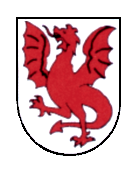Basilisk (heraldic animal)

The Basilisk is in the heraldry as a heraldic animal in the series of common characters .
As a common figure, heraldic animal or shield bearer, the basilisk is rarely found in coats of arms . Nevertheless, it has a certain fame as Basel's heraldic animal . A thaler from 1741 shows the obverse of the city of Basel and above it the coats of arms of the eight bailiwicks. In the lapel a basilisk with the coat of arms and the marginal writing CONCORDIA ... The basilisk is also known as a wyvern or rooster dragon .
meaning
Outside of heraldry, the basilisk means, among other things:
- Heresy , devil and antichrist (e.g. in the Catholic symbolism of the 16th / 17th century: basilisk = king of the serpents = Satan = reformation)
- Plague and death (the breath of a basilisk is supposedly "deadly poisonous")
- Expulsion (based on the role of the snake in the expulsion of Adam and Eve from Paradise)
Representation and Blazon
In heraldry, the basilisk is a mixture of rooster, snake and dragon, whereby the transitions to other heraldic motifs such as amphisbaena , lindworm , griffin and harpy are fluid. The heraldic representation is always in profile, usually looking to the right (heraldic). She limits herself
- either on a rooster with a man's head and a pointed hat (as shown in the coat of arms of Ceska Trebova / Böhmisch Trübau )
- or as a dragon-like, two-legged and winged animal with a rooster head and snake tail (and optionally a crown for the attribute "King of the Snakes" ).
The design of the rooster head and the often thrown feet are often based on the eagle , the wings and the body on the dragon . The tail end is shown either as an arrow (like a dragon) or as a second head (dragon, snake, skull or similar). The weaponry (claws, beak, tongue and bird legs) is often a different color tinged .
Itzgrund coat of arms
Coat of arms of Basel : basilisk as shield holder (original mirrored)
Coat of arms of Ried im Oberinntal
The Bornholm coat of arms also shows a basilisk, although the griffin is also common in the Baltic Sea region .
See also
Individual evidence
- ↑ Julius R. Erbstein , H. Albert Erbstein : The Isaak von Peyersche Münz- und Medals-Cabinet belonging to the city of Nuremberg. Sebald, Nuremberg 1863, p. 12 .
- ↑ Christian Samuel Theodor Bernd : The main pieces of coat of arms science. Section 1. From the author and from Ed. Weber, Bonn 1841.
Web links
- Basilisk ( heraldic animal) in the Heraldry Wiki



